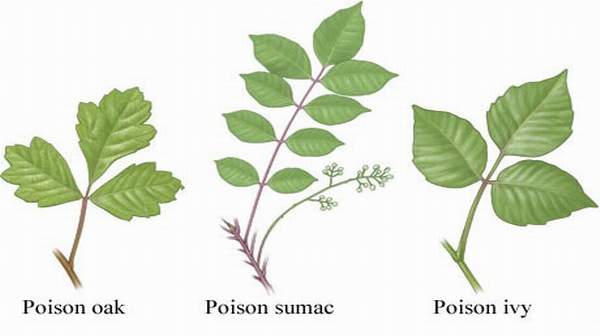What's in this article?
What is Poison Oak Rash?
Poison oak rash is an allergic reaction to the leaves or stems of the western poison oak plant (Toxicodendron diversilobum). The plant looks like a leafy shrub and can grow up to six feet tall. In shady areas, the plant can grow like a climbing vine. The leaves usually have three separate leaflets, but there can be up to nine leaflets, each about one to four inches long.
What are the causes of poison oak?
Fluid in the blisters does not contain the toxic poison oak chemical, urushiol. If the blisters break, the fluid will not result in spreading of the poison oak. Scratching other parts of the body with contaminated fingernails, however, may spread poison oak, and urushiol can remain under the nails for several days unless the nails are extensively cleaned. A person who has washed thoroughly and has changed into clean clothing will not spread poison oak. The only way to get poison oak is through direct contact with the toxic resin, for example by coming in contact with a contaminated person who has not washed properly or changed into clean clothes.
Other secondary exposures may result from handling garden, hunting or sports equipment, or camping gear exposed to poison oak. Thick fur protects most pets that run through poison oak patches from developing symptoms. However, people who touch contaminated pets can come directly in contact with the resin and may develop poison oak. What are the symptoms?
Severity of poison oak skin reaction depends on the degree of patient sensitivity, the amount of exposure, and on which body parts are exposed. Sensitive body parts, including the eyes, lips, and genitals exposed to poison oak sap will experience a more severe reaction.
Skin irritation characterized by redness, blistering, swelling and severe itching generally develops 24-48 hours after the exposure. Some victims experience symptoms after as little as 30 minutes. Others may not have symptoms until 14 days following exposure. In typical cases, the reaction is most severe five days after the exposure. Mild cases of poison oak last from seven to 10 days. Severe cases may last up to three weeks or longer. People with pale skin are more susceptible than dark-skinned people and younger people are more susceptible than the elderly.
Burning poison oak will produce a dangerous smoke that can cause severe symptoms to the eyes, nose, throat and lungs.
Signs of Allergy
If you’re allergic to poison oak, signs will begin to appear one to six days after exposure. Most of the time, you’ll notice it within the first 24 to 48 hours.
The most obvious evidence of an allergic reaction is skin rash, also called dermatitis. First, you’ll notice some stinging, itching, and minor skin irritation. Eventually, you’ll break out in a red rash that gets itchier as it progresses. The rash will be worse in the areas that had direct contact with the plant. Bumps will start to form and eventually turn into large blisters that ooze liquid. Within a few days, the blisters will begin to dry up and form a crust.
Poison oak rash is most likely to appear around your wrists, ankles, and neck, where the skin is thinner. The rash usually peaks about a week after exposure and lasts 5 to 12 days. In rare cases, it can last a month or more.
How is it diagnosed?
The main symptom of poison oak, poison ivy, or sumac is an extremely itchy, red rash that appears within 24 to 72 hours of exposure to the oil. The rash often appears streaked, and may develop into oozing blisters. In general, the skin rash may be uncomfortable. It is not serious, though, and usually resolves on its own in one to two weeks. However, you should contact a doctor immediately if you are highly sensitive or have the following symptoms:
- swelling of the face or throat
- rash on the genitals
- swelling or rash that covers more than one third of your body
- rapidly spreading rash
- signs of a bacterial infection, such as pain, increased redness, or pus.
Diagnosis of poison ivy, oak, or sumac is based on the presence of a characteristic itchy rash, and possible exposure to plants containing urushiol oil.
Home Remedies
Most of the time, poison oak rash can be treated at home. If you think you’ve been exposed, you should remove your clothing. Wash your body well with plenty of warm water and soap. Pay special attention to hands, fingernails, and whatever skin may have touched the plant.
Wash your clothes and anything else that may have come into contact with the poison. The oils from the plant can remain on fabric and other materials and can give you another rash.
The rash can be very itchy and the temptation to scratch is strong, but scratching can cause an infection. Touching the blisters can also result in infection. Take lukewarm baths or cool showers to ease itching.
Over-the-counter remedies like calamine lotion or hydrocortisone cream may temporarily take care of the itch. You can also try applying cool compresses to the itchy patches. Antihistamine pills can also help with the itching. But be careful antihistamine on your skin will make matters worse.
What is the conventional treatment of poison oak?
Treatment consists mostly of protecting the damaged skin, preventing infection and relieving the itching. Over-the-counter medications may be used as poison oak treatments and as a poison ivy remedy. Store-brand or generic versions of these medications also work and are usually available. If the case of poison oak is severe, you should see a physician for more extensive poison oak treatment with stronger steroid medications.
Avoid the use of older Caladryl that contains the ingredient “diphenhydramine,” unless directed by your physician. Applying diphenhydramine to open sores and taking diphenhydramine by mouth can cause a toxic build-up of the drug.







